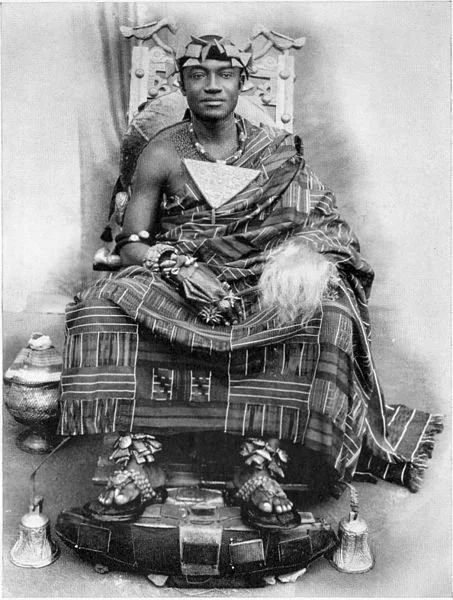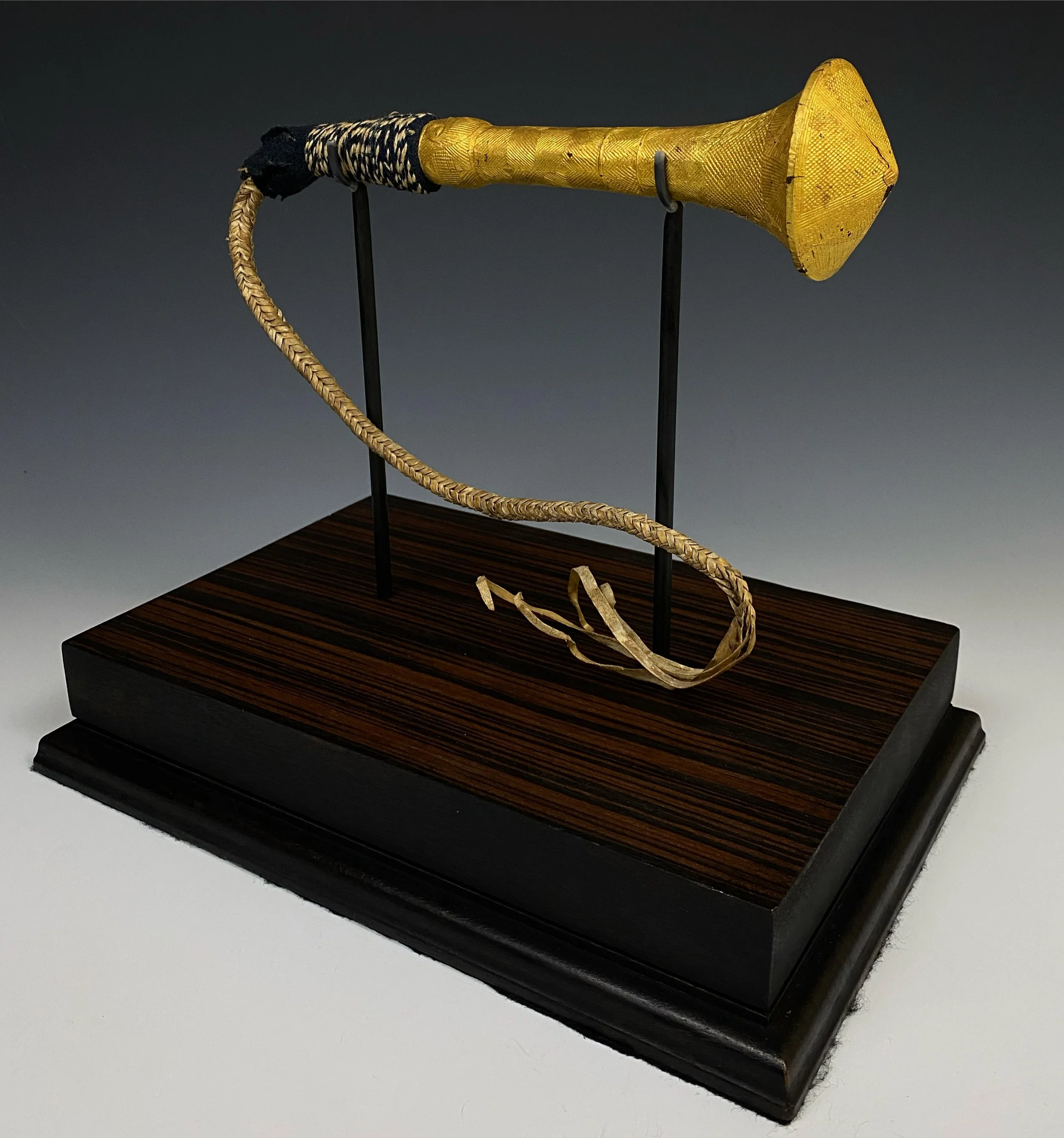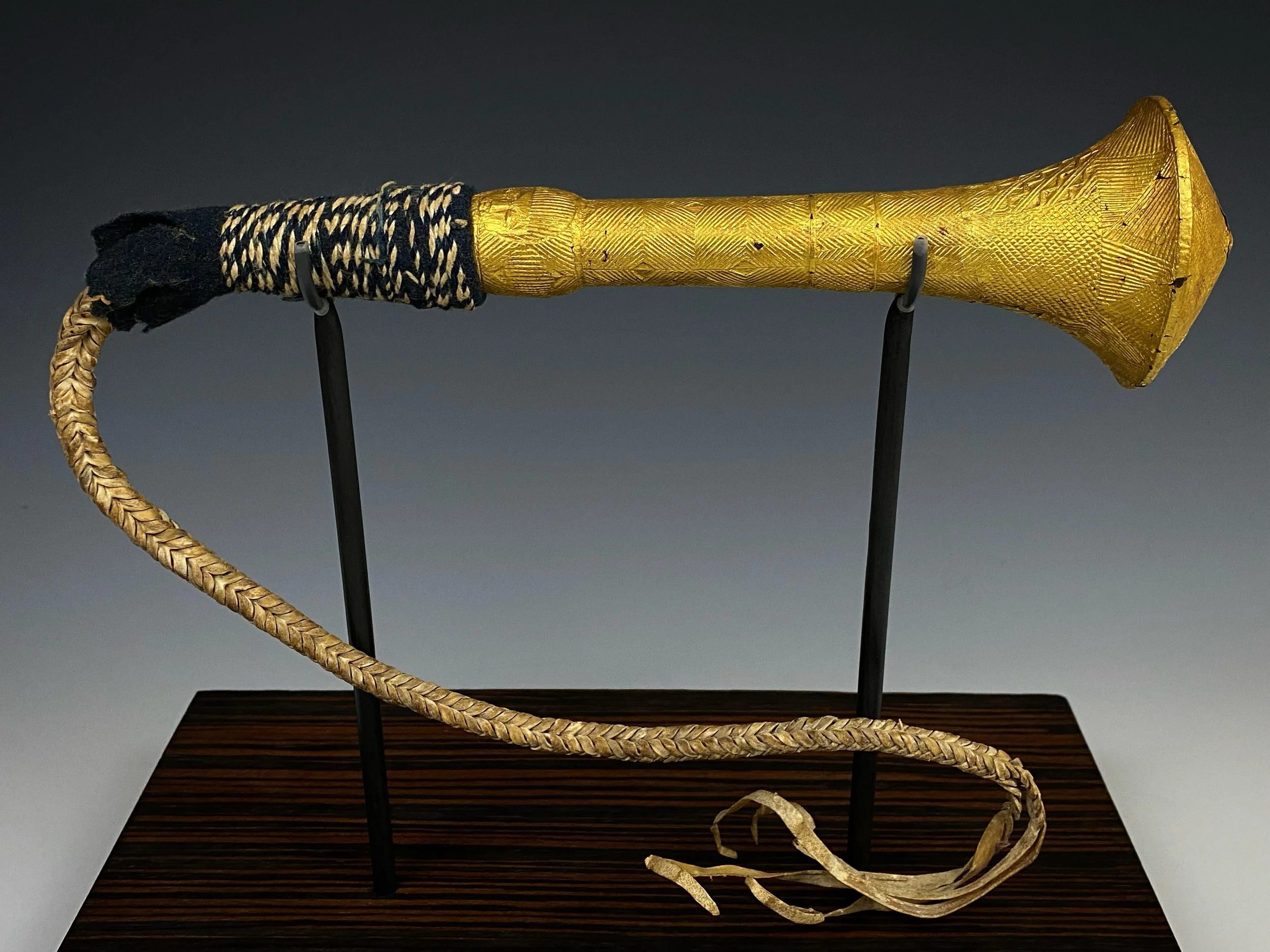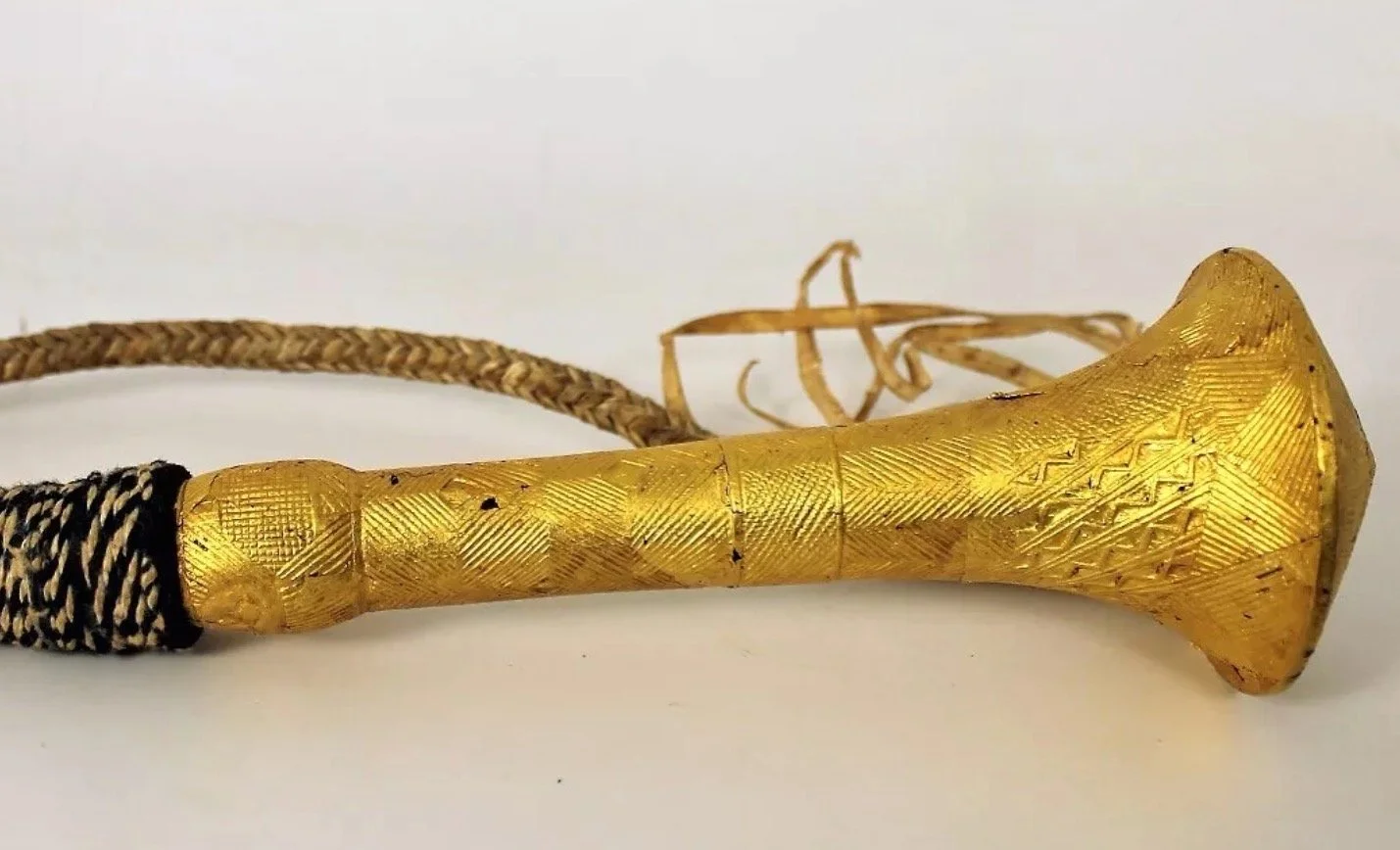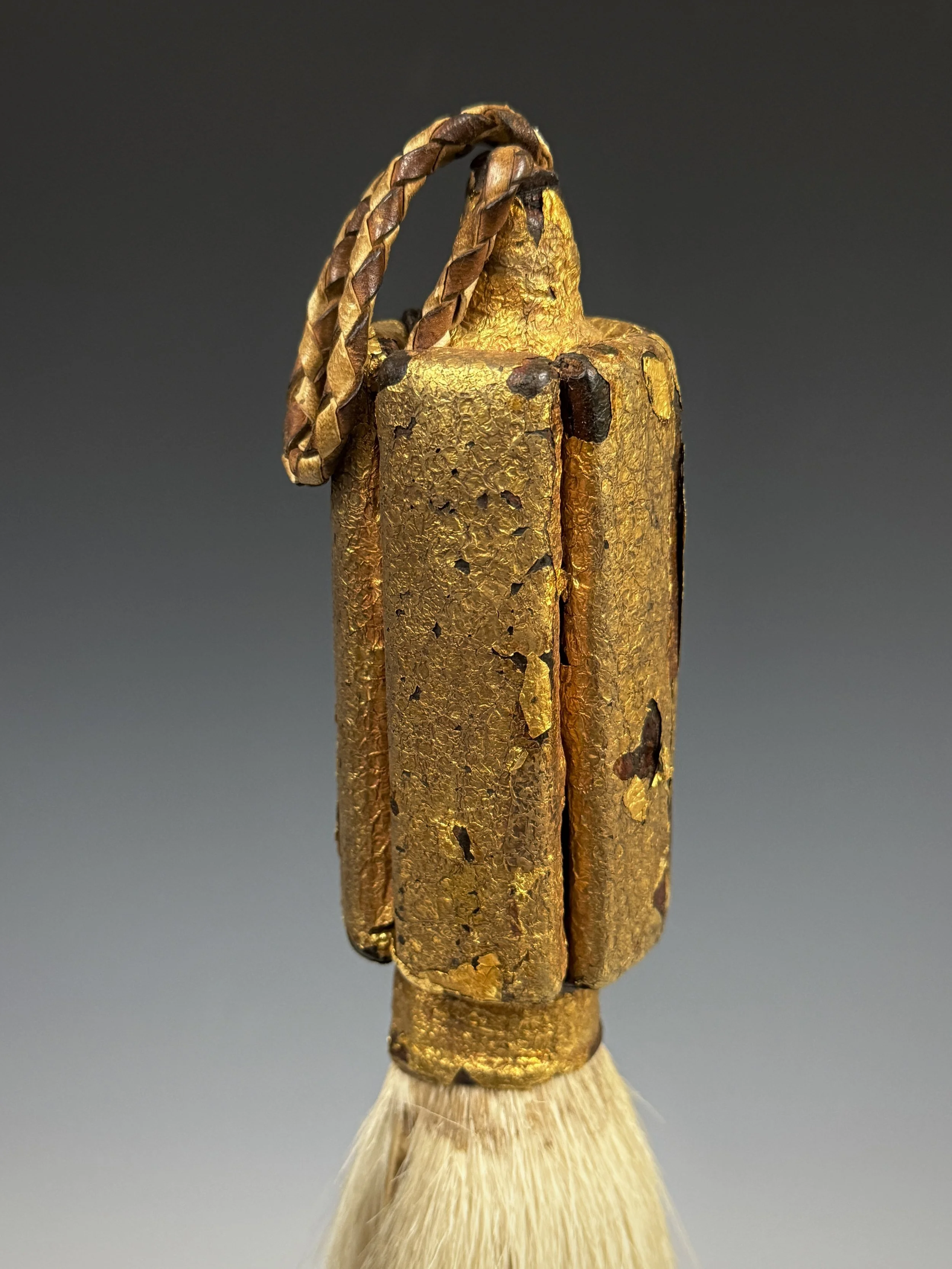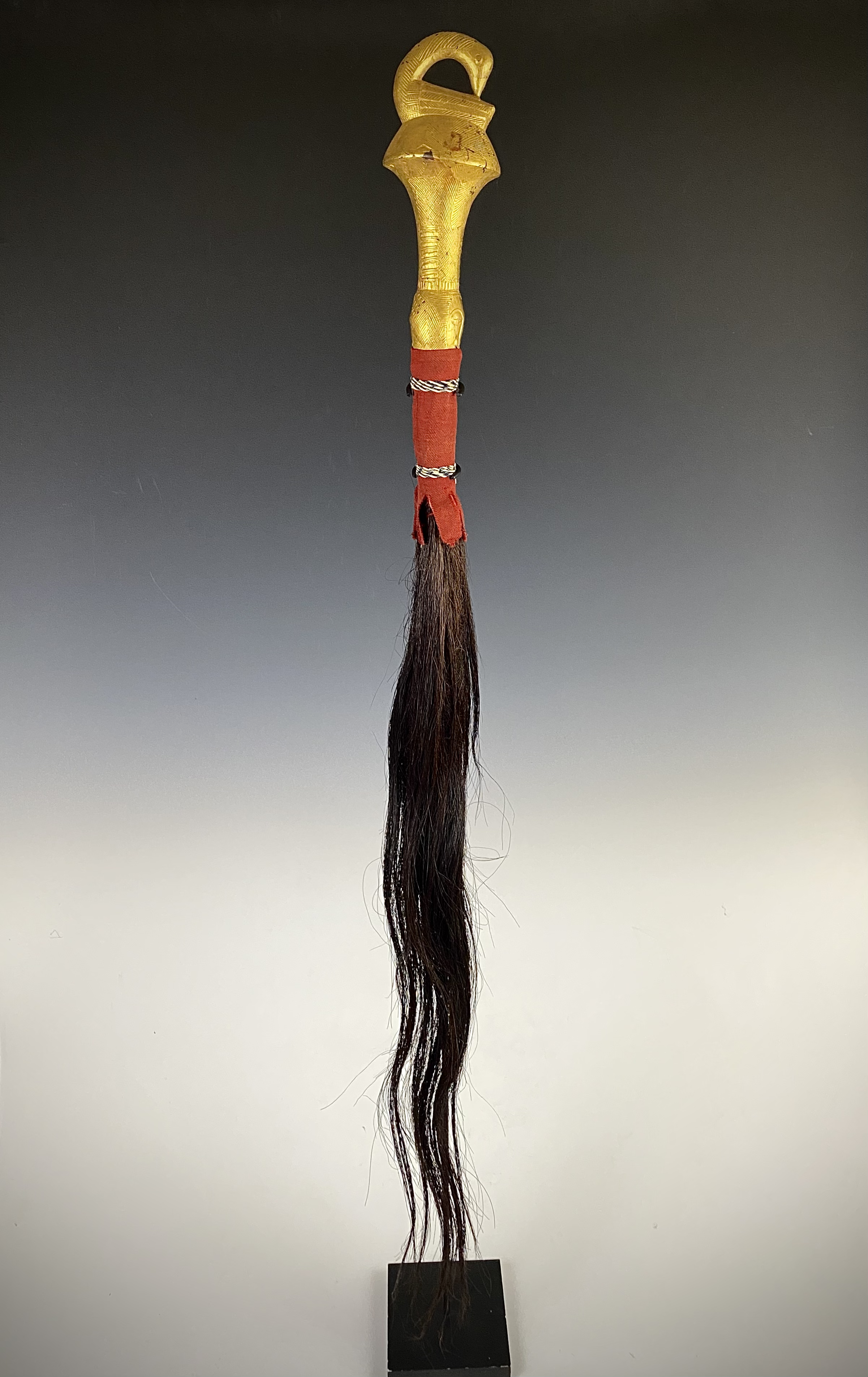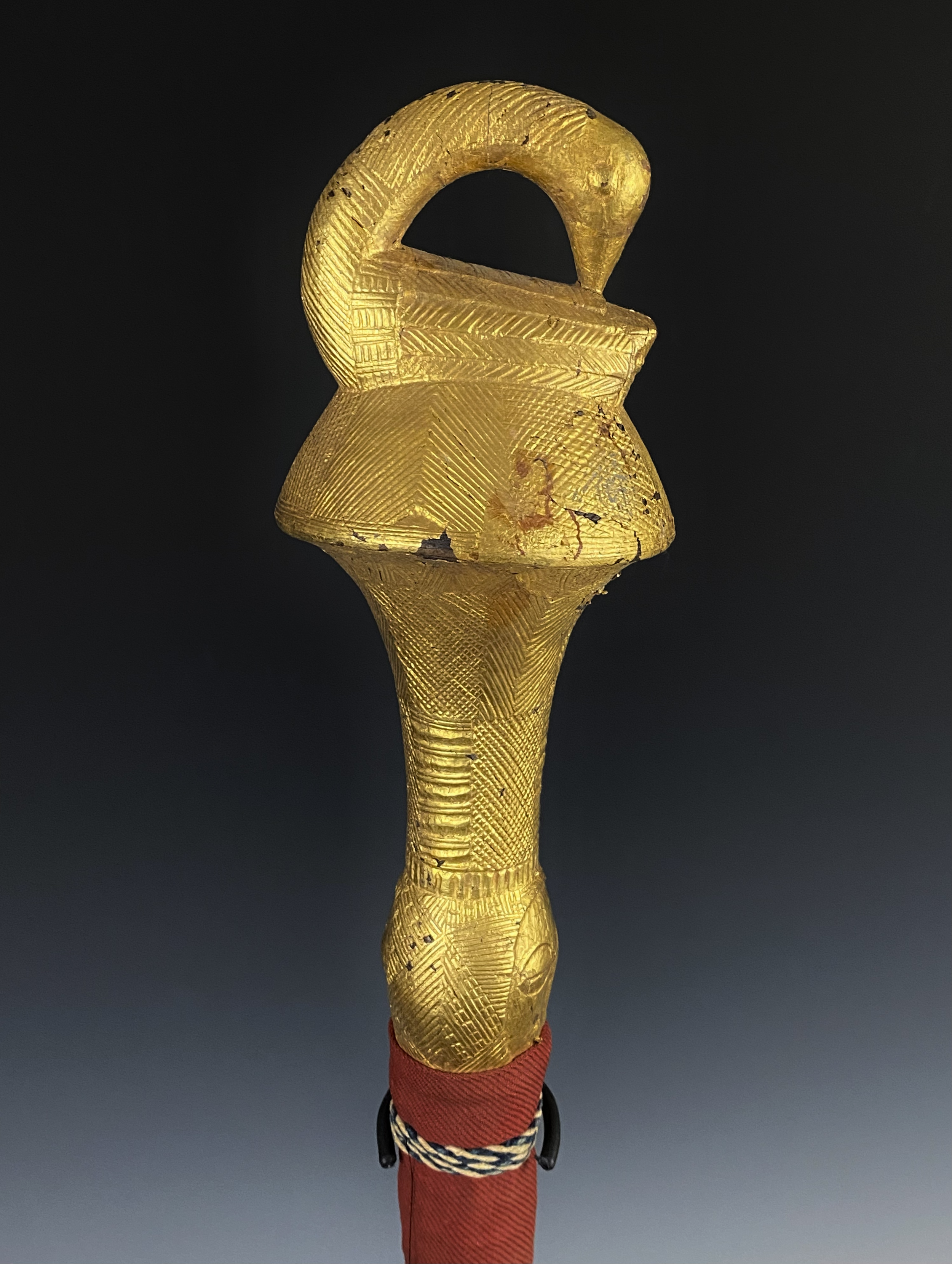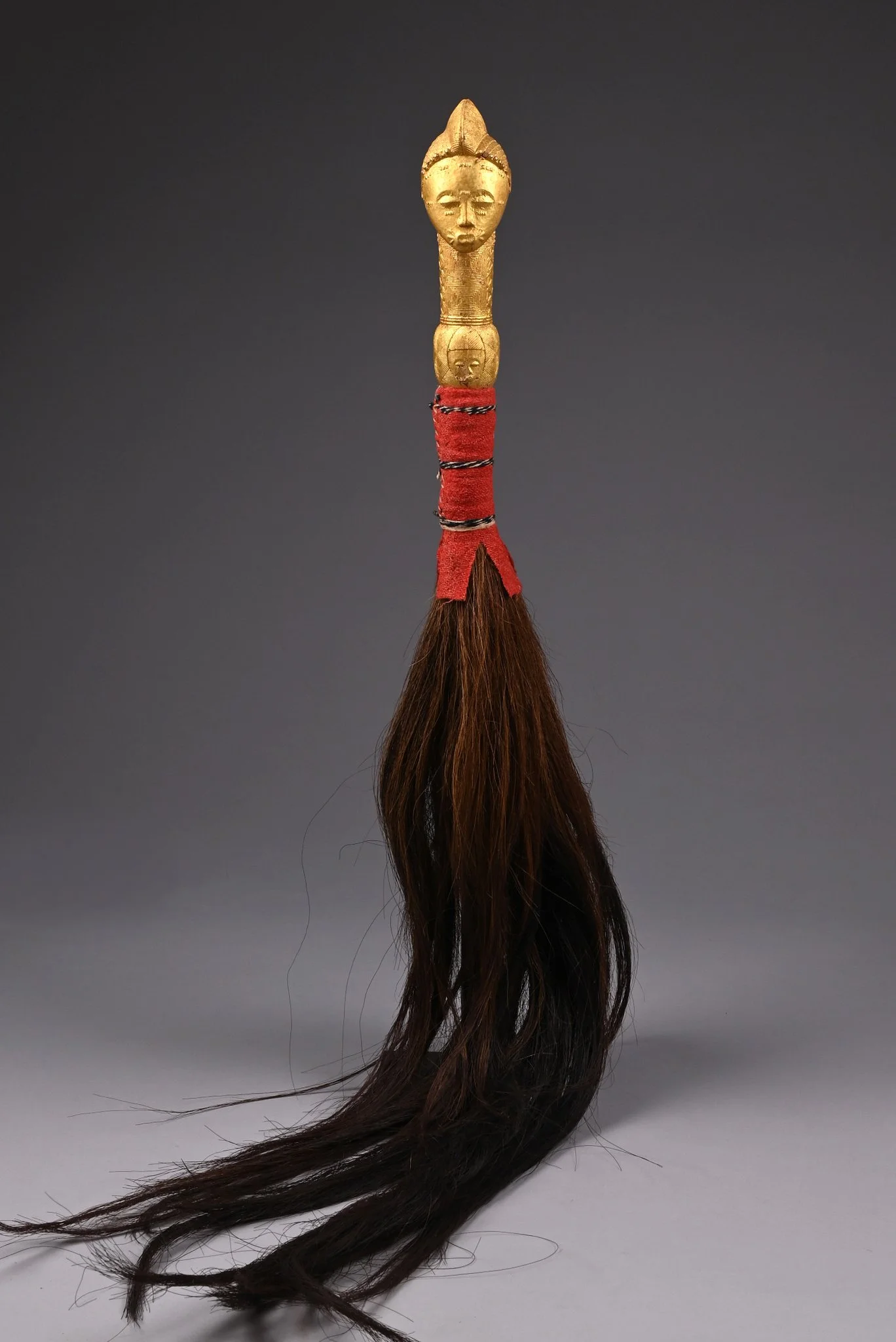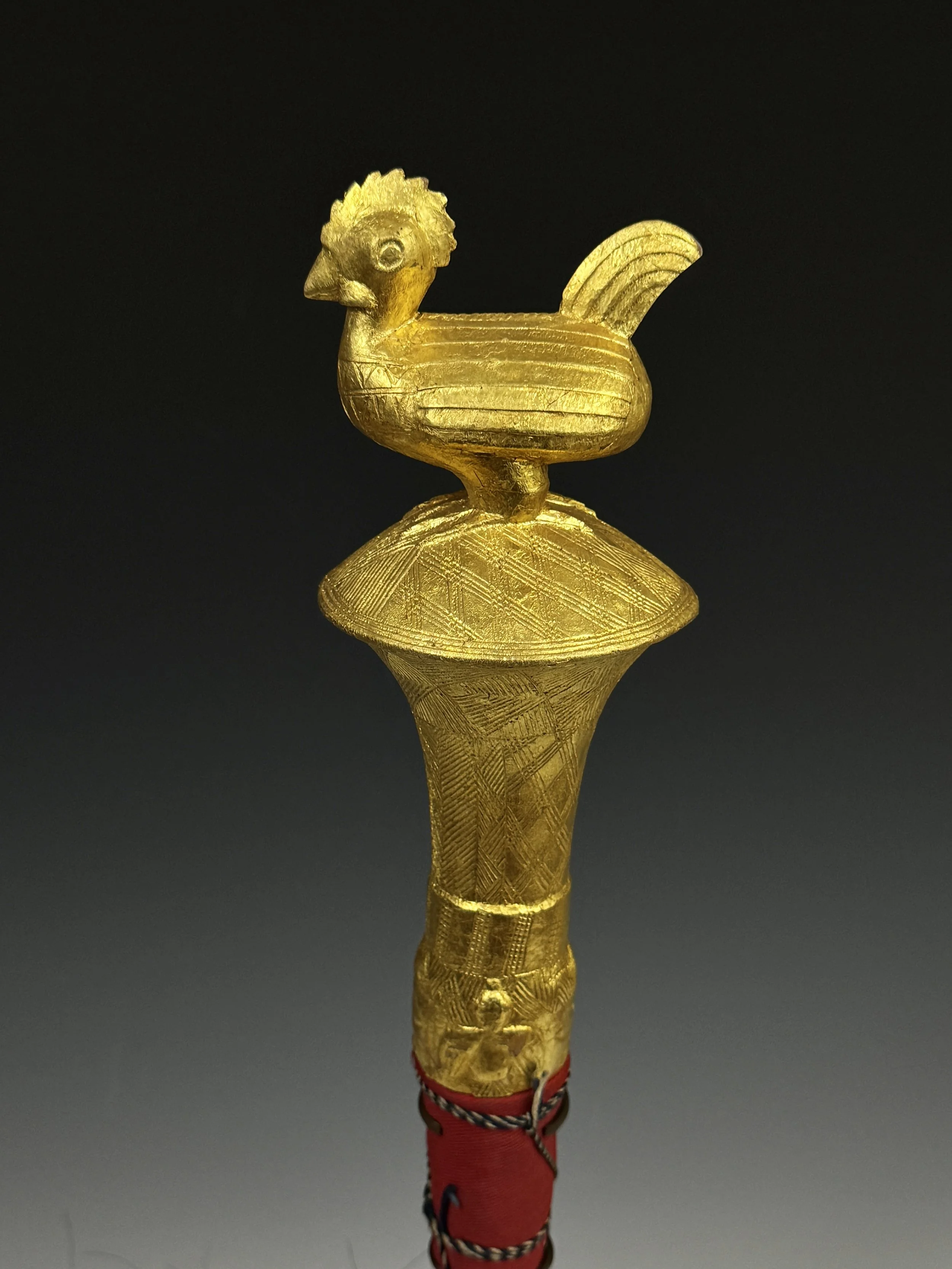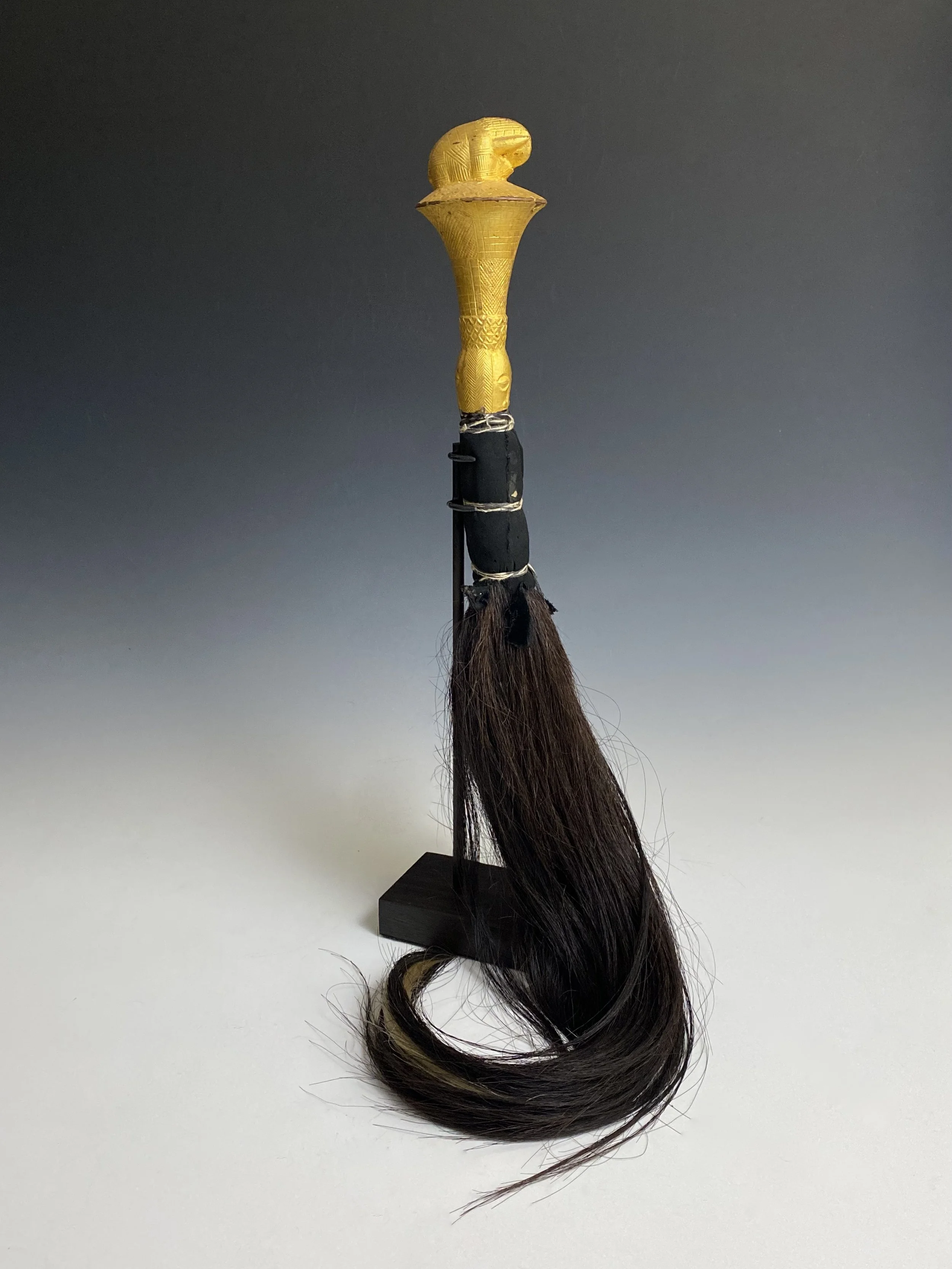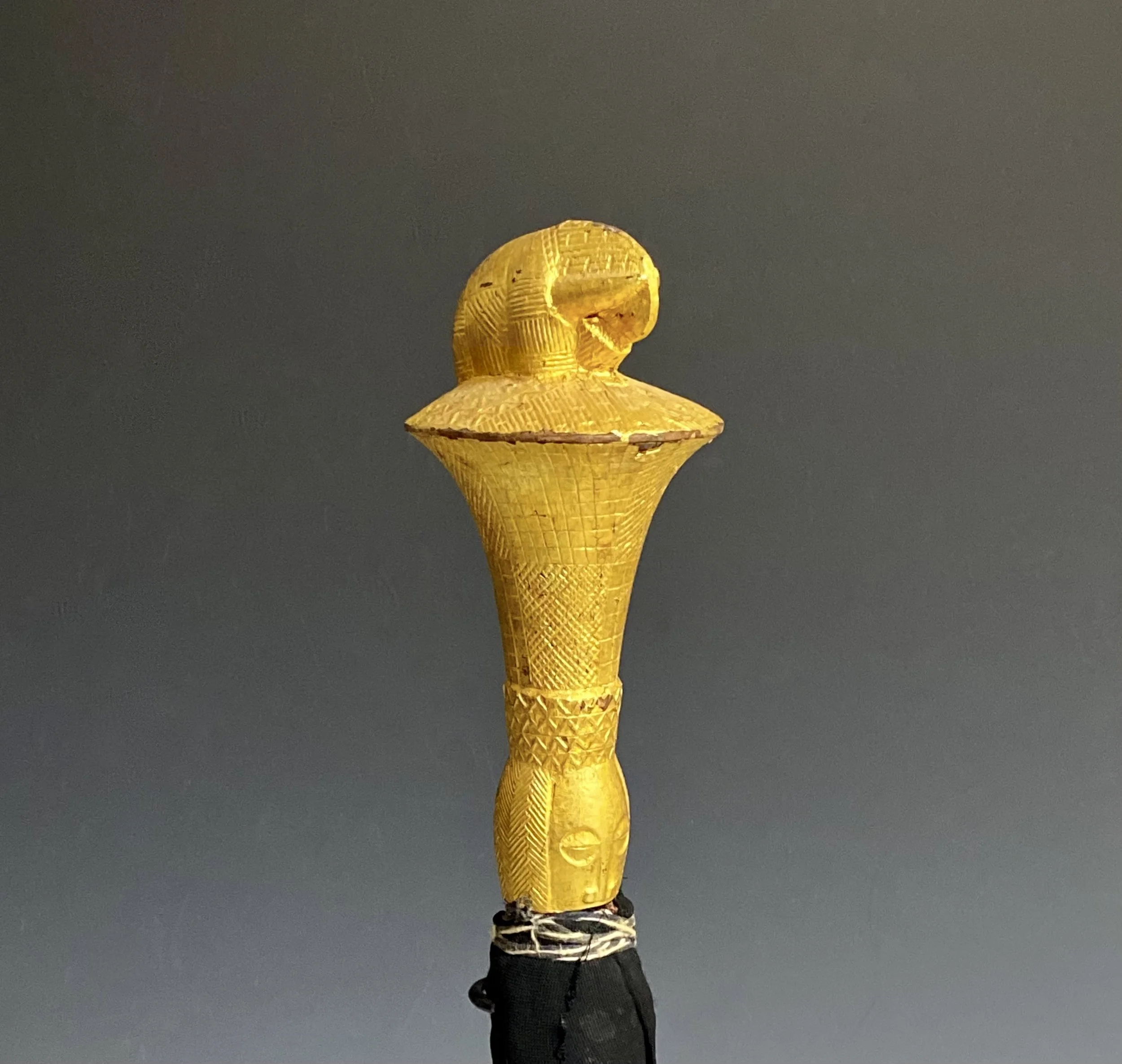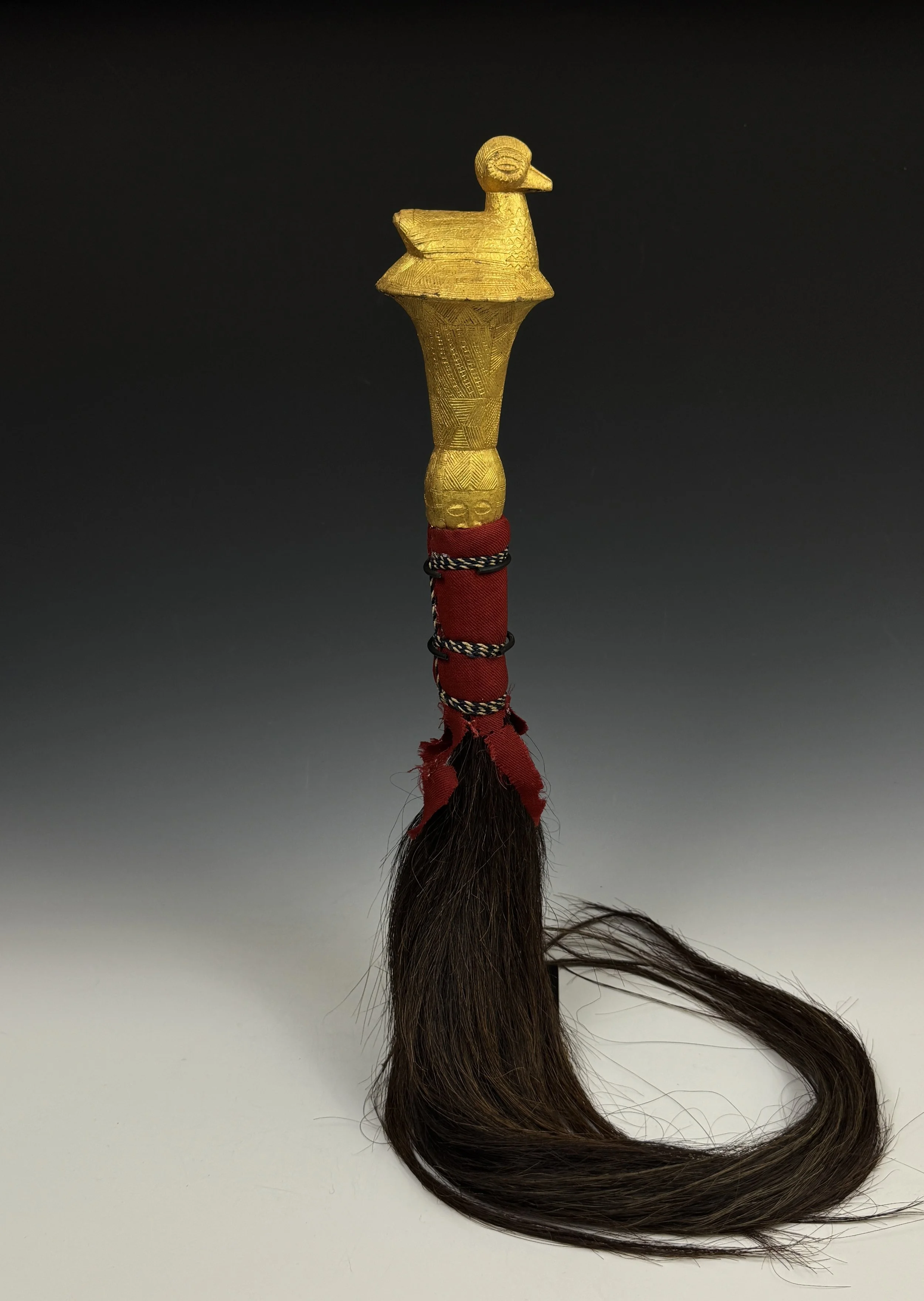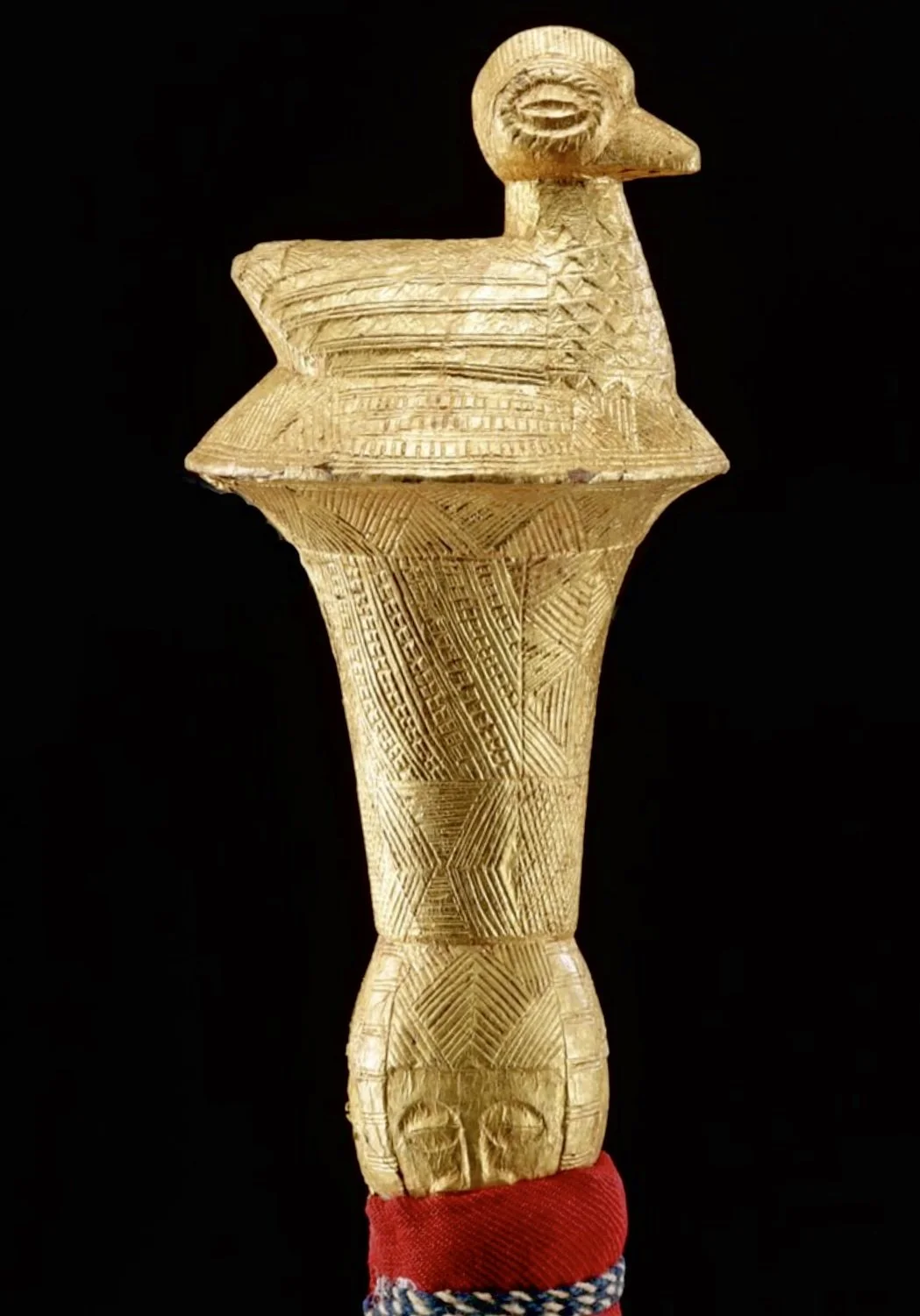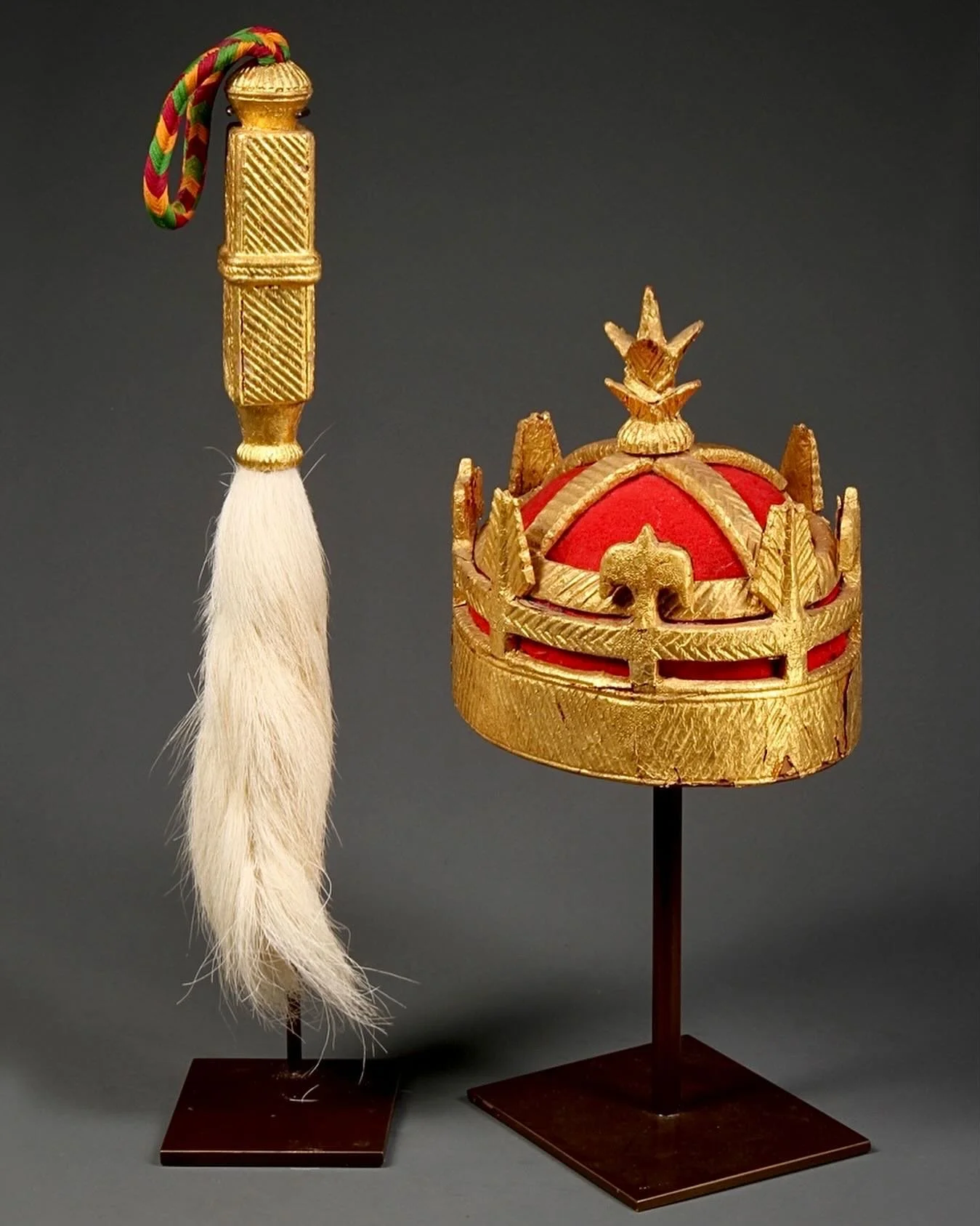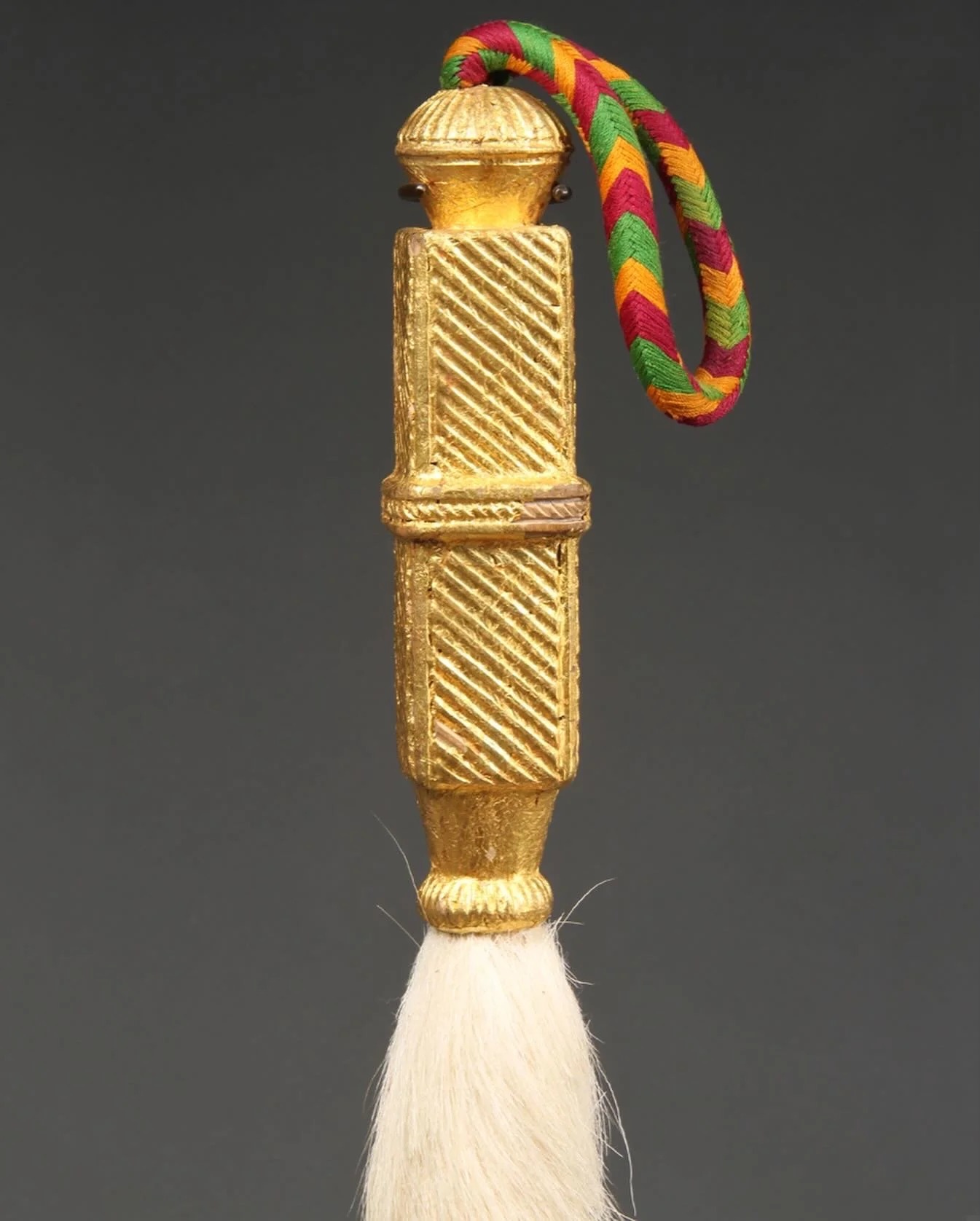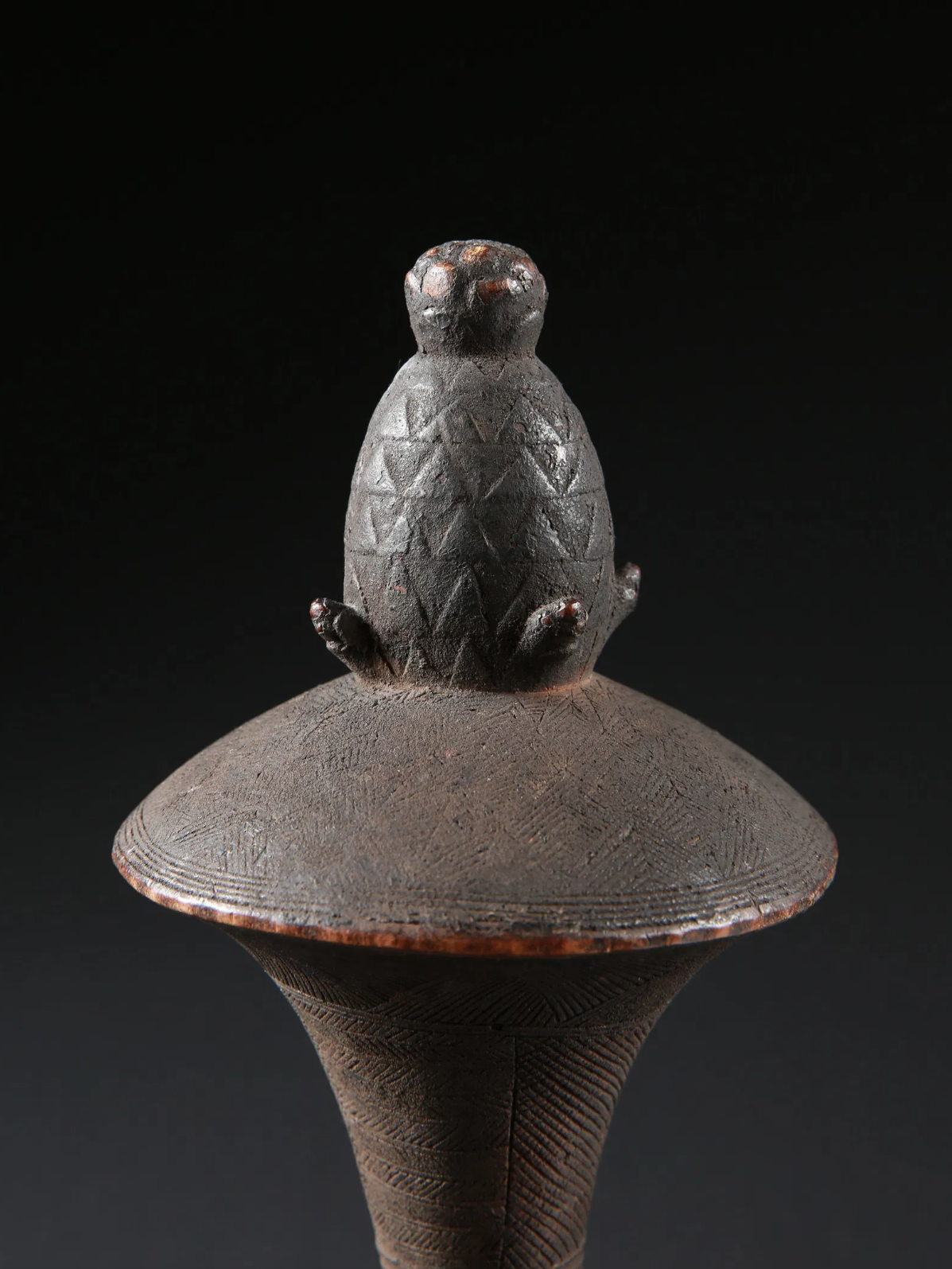Nandwa Blawa
Akan and Baule fly whisks, also known as "nandwa blawa", are ceremonial objects used by the Akan and Baule people of Ghana and Ivory Coast. These fly whisks are typically made from the tail hairs of animals such as horses, or elephants, which are bound together and attached to a handle made from wood, textiles, and gold foil.
The Akan and Baule fly whisk is an important symbol of authority and power, and is often carried by chiefs, elders, and other important individuals during formal occasions and ceremonies. Although the fly whisk is used as a practical tool for swatting away insects, the purpose is more for protecting the individual from evil spirits and unseen forces meant to do harm.
The Asantehene Nana Otumfoe Sir Osai Agyemang Prempeh II (King of Asante) shown here in regalia holding a fly whisk in his left hand.
An intricately carved wood Baule fly whisk (nandwa blawa). The gold foil covering the carving is high purity. Here the typical horse tail hair is replaced with a whip woven out of hide. “Perhaps the most distinctively Baule items of regalia are the gold-covered horse-tail fly whisks (nandwa blawa). The handles of these symbols of authority are artistically elaborated far beyond anything the Ghanaian Akan produced. A lineage head or “chief” may have five to ten or more fly whisks. Garrard cites a Baule proverb that helps explain the whisks, “money (gold) is like a fly-whisk, a single person cannot catch it.” Today you may have money, but tomorrow you will be poor again (1993c,156). According to some, their function is less to drive away flies than to dispel evil spirits or “witchcraft”. The king is kept pure and protected from harmful forces through soft stroking by the whisk bearers. “-D.Ross. EX private New York City estate.
“Asante white horsetail whisk (bodua) with a handle of four rectangular amulets (nsɛbɛ) of wood and leather covered with gold foil. Whisks with attached amulets are known as sɛbɛ bodua. On public occasions they are held or carried before the chief by his attendants. They are not used primarily as fly whisks, but serve to drive evil spirits from the royal presence. The white horsetails used for these whisks are not of local origin, but were formerly imported from Europe.” -T. Garrard, African Gold. “Horses, due to the tsetse fly, did not live long in the Akan forests, it is the horse-tail fly whisk that is explicitly involved with war. Rattray cites the proverb, "If the horse does not go to war, its tail does," and explains, "A horse's tail is considered a charm to bring victory to an army, and is always taken on a campaign by a general and his captains" The source of this belief is difficult to decipher, but it may derive from the perceived power of mounted warriors north of the forest, although the Asante defeated the cavalry of both the Gonja and Dagomba in the eighteenth century. Despite the fact that a chief may have attendants who carry his whisks during festival occasions, a horse tail whisk is still carried by a chief in his left hand when he is in procession, either walking or carried in a palanquin, while he holds a sword in his right. Both recall the military foundations of most Akan states,but also serve as dance implements accenting and extending the gestures of the chief while he performs for and honors his subjects.”-D. Ross. From the estate of René David, Zurich, Jean L. David, Galerie Walu. Published: Gold in the art of West Africa. Zurich: Gallery Walu. Page 8. Exhibited: Helvetic Gold Museum Burgdorf. "Gold in West African Art" (2009).
A fly whisk made of an elephant tail is known as “mena”. Wood, covered with gold foil, elephant tail/ hair, textile. H 70 cm. “At one time elephant tail fly whisks (mena) were ubiquitious in the courts of many Akan chiefs. At the Asante Odwira festival of 1817, Bowdich observed “Elephant tails waving like a small cloud.” A photograph from the 1960s, taken as part of Kyerematan’s study for The Panoply of Ghana documents twenty-three elephant tail fly whisks in the regalia at NKoranza. Traditionally the whisk was a symbol of entitlement, the “heraldic badge” earned by the ɔbirɛmpɔn (big man) and conferred by the Asantehene. This title was given to the most successful accumulators of wealth and was held by the heads of the hereditary chiefdoms. In the Asante kingdom, only the Asantehene is allowed to possess a gold-handled elephant tail. There has been substantial speculation on the relationship between wealth and the elephant tail. Wilks considers it in relation to the proverb, “The elephant’s tail is short, but it is able to sweep flies away.” He goes on to explain: The sense is that the elephant did not allow the handicap of a short tail to prevent him from achieving preeminence...thus should the citizen sweep away all obstacles in his or hers pursuit of riches. The elephant tail or mena is the symbol in other words, not so much as wealth as such, but rather of the accomplishment and achievement which characterize the acquisitive process. (Wilks 1975,15).-D.Ross. Provenance: Galerie Walu, Zurich, Switzerland
Akan fly whisk, "nandwa blawa", Côte d'Ivoire/ Ghana, Wood, covered with gold foil, horse tail hair, textile. H 46 cm. (112 cm with tail). “One of the most familiar and influential images in all of Akan art is the bird with its head turned toward its back--the so-called sankɔfa bird. Its message is most frequently translated as "Pick it up, if it falls behind."The basic idea is that if you have forgotten something, you can return to retrieve it, or that mistakes can be corrected. In part the motif has to do with maintaining and respecting ancestral tradition.” (D.Ross) ex Galerie Walu
A beautifully carved Baule fly whisk, "nandwa blawa", Côte d'Ivoire. Wood, horse hair, textile. H 47cm. Fly-whisks are not used primarily as fly-whisks, but serve to drive evil spirits from the chief’s presence. EX Galerie Hilt, Balz Hilt (1931-1997), Basel, 1970. EX Sandro Bocola (1931-2022), Zurich.
A Baule Fly Whisk (Nandwa Blawa) from Côte d'Ivoire, wood, gold foil, fabric, horse-tail. This fly whisk represents an ancestor to honor the spirits, an ever-present theme in Baule art objects. Covered with gold foil, fly whisks like this example was part of the regalia of chiefs and dignitaries and are presented on public occasions as a sign of rank and status. As part of the sacred family heritage "aja", they are displayed in honor of the deceased during funeral ceremonies. EX Zemanek Münster, Germany. EX Private Collection.
Baule fly whisk. Handle: 40cm H. Wood covered with gold foil, horse hair, textile, Côte d’Ivoire. The finial image is of a standing rooster. “Akokg ntakdra na emd akoko ye kese”, —It is the feathers on a fowl that make it big. (This saying has been heard in the sense that it is the number of subjects whom a chief has who make him important.). Another is "Although the hen knows that the dawn is breaking, she leaves it to the rooster to announce." EX Giquello, Paris.
Akan Fly whisk if a notable with an elephant finial. Wood, gold foil, textile, L: 28 cm / 100 cm, L: 11,0 inch / 39,4 inch Côte d’Ivoire or Ghana. EX Zemanek Münster Germany. EX Dieter Schaffner, Groß-Gerau , Germany
Baule fly whisk with a finial of a bird- this time a water fowl. 33” L. Wood, covered with gold foil, horse hair, and textile. Côte d’Ivoire. EX Constance McCormick Fearing estate, Montecito, California.
The fly whisk shown here with a chief's crown, is another important part of the chief’s regalia and a chief still carries a horse tail whisk in his left hand when he is in procession. A proverb for the horse tail fly whisk is “If the horse does not go to war, its tail does”. The tail is considered a charm to help bring victory. White horse here are not found in Ghana and are imports from European sources. Ex Morton Dimondstein, Los Angeles
Baule fly whisk handle, "nandwa blawa", Côte d'Ivoire. Wood. H 33 cm. The pineapple finial said to represent sovereignty to the Akan in chief’s regalia can also be interpreted as the pineapple takes time to mature and won’t be sweet if eaten early — a statement on the patience of the chief. This can also be seen as patience for selecting an accomplished and experienced chief. Provenance: Pierre and Hedwige Sennwald, Lausanne.
